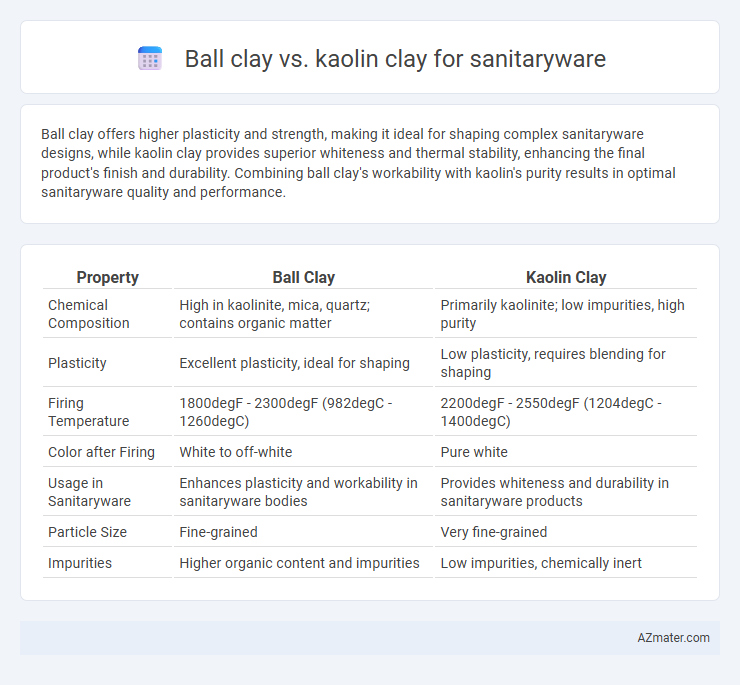Ball clay offers higher plasticity and strength, making it ideal for shaping complex sanitaryware designs, while kaolin clay provides superior whiteness and thermal stability, enhancing the final product's finish and durability. Combining ball clay's workability with kaolin's purity results in optimal sanitaryware quality and performance.
Table of Comparison
| Property | Ball Clay | Kaolin Clay |
|---|---|---|
| Chemical Composition | High in kaolinite, mica, quartz; contains organic matter | Primarily kaolinite; low impurities, high purity |
| Plasticity | Excellent plasticity, ideal for shaping | Low plasticity, requires blending for shaping |
| Firing Temperature | 1800degF - 2300degF (982degC - 1260degC) | 2200degF - 2550degF (1204degC - 1400degC) |
| Color after Firing | White to off-white | Pure white |
| Usage in Sanitaryware | Enhances plasticity and workability in sanitaryware bodies | Provides whiteness and durability in sanitaryware products |
| Particle Size | Fine-grained | Very fine-grained |
| Impurities | Higher organic content and impurities | Low impurities, chemically inert |
Understanding Ball Clay and Kaolin Clay
Ball clay and kaolin clay are essential raw materials in sanitaryware manufacturing, each offering distinct properties that influence product quality. Ball clay is highly plastic, containing fine particles and organic matter, which enhances the workability and mechanical strength of ceramic bodies. Kaolin clay, characterized by its high purity and whiteness due to low iron content, provides excellent chemical resistance and a smooth surface finish, crucial for sanitaryware aesthetics and durability.
Key Properties of Ball Clay
Ball clay features high plasticity and excellent workability, making it ideal for shaping intricate sanitaryware components. Its fine particle size and high organic content enhance dry strength and green strength, ensuring durability during forming and handling. The high fusion point and minimal impurities in ball clay contribute to a smooth finish and robust fired strength in sanitaryware production.
Key Properties of Kaolin Clay
Kaolin clay is highly valued in sanitaryware manufacturing for its fine particle size, high whiteness, and low impurity levels, which contribute to a smooth, durable, and aesthetically appealing finish. It has excellent plasticity and refractoriness, allowing it to withstand high firing temperatures without deforming. Unlike ball clay, kaolin has lower shrinkage and higher brightness, making it indispensable for producing lightweight, strong, and high-quality sanitaryware products.
Chemical Composition Differences
Ball clay contains higher kaolinite content combined with significant amounts of mica and quartz, resulting in greater plasticity and strength, which is essential for shaping sanitaryware. Kaolin clay mainly consists of pure kaolinite with low impurities, offering excellent whiteness and refractory properties but lower plasticity compared to ball clay. The chemical composition difference, especially the higher fluxing oxides like iron oxide and alkalis in ball clay, influences firing behavior and final product durability in sanitaryware manufacturing.
Plasticity and Workability Comparison
Ball clay exhibits higher plasticity compared to kaolin clay, making it essential for enhancing the workability of sanitaryware bodies. Kaolin clay, while lower in plasticity, provides strength and whiteness but requires blending with ball clay to improve shaping and molding processes. The optimal combination of ball clay and kaolin clay balances plasticity and workability, ensuring durability and surface finish quality in sanitaryware manufacturing.
Firing Temperature and Shrinkage
Ball clay used in sanitaryware typically fires at a lower temperature between 1200degC and 1250degC, producing higher plasticity and greater shrinkage rates of about 15-18%. Kaolin clay requires higher firing temperatures around 1300degC to 1400degC, resulting in lower shrinkage rates near 8-12% due to its coarser particle size and refractory nature. The balance between firing temperature and shrinkage influences the final strength, whiteness, and dimensional stability of sanitaryware products.
Impact on Sanitaryware Strength and Durability
Ball clay, with its high plasticity and fine particle size, enhances the green strength and plasticity of sanitaryware, enabling detailed shaping and reducing drying defects. Kaolin clay contributes to the fired strength and durability by providing alumina and silica content, resulting in a dense, vitrified body with improved resistance to wear and chemical attack. Combining ball clay and kaolin optimizes the balance between workability during forming and mechanical strength after firing, directly influencing sanitaryware's long-term performance and robustness.
Color and Surface Finish Outcomes
Ball clay in sanitaryware provides a creamier, off-white color that enhances warm tones in finished products, whereas kaolin clay contributes a purer, bright white base ideal for crisp color contrasts. The fine particle size and plasticity of ball clay improve surface smoothness and casting performance, resulting in refined, glossy finishes. Kaolin clay's high purity and whiteness elevate brightness and translucency, producing a cleaner, sharper final surface in sanitaryware applications.
Cost and Sourcing Considerations
Ball clay offers a cost advantage over kaolin clay due to its lower mining and processing expenses, making it a preferred choice for budget-sensitive sanitaryware manufacturing. Kaolin clay, although more expensive, provides superior purity and whiteness, which can enhance the aesthetic quality of sanitaryware products. Sourcing ball clay is often more accessible globally, while kaolin deposits are region-specific, impacting logistics and overall supply chain costs.
Choosing the Right Clay for Sanitaryware Production
Ball clay offers superior plasticity and binding properties essential for shaping sanitaryware, while kaolin clay provides high whiteness and refractory qualities vital for the final product's durability and aesthetic appeal. Selecting the right clay involves balancing ball clay's excellent workability with kaolin's strength and whiteness to achieve sanitaryware with optimal mechanical strength, surface finish, and resistance to thermal shock. Manufacturers often blend ball clay and kaolin in specific proportions to enhance moldability and firing performance, ensuring efficient production and high-quality sanitaryware.

Infographic: Ball clay vs Kaolin clay for Sanitaryware
 azmater.com
azmater.com